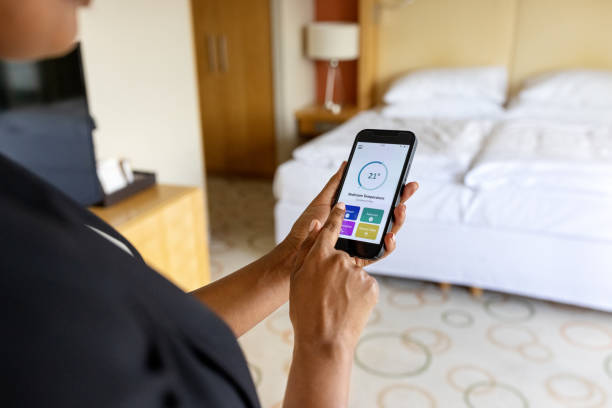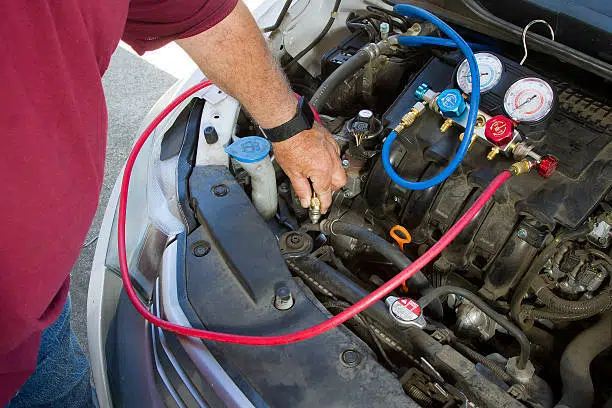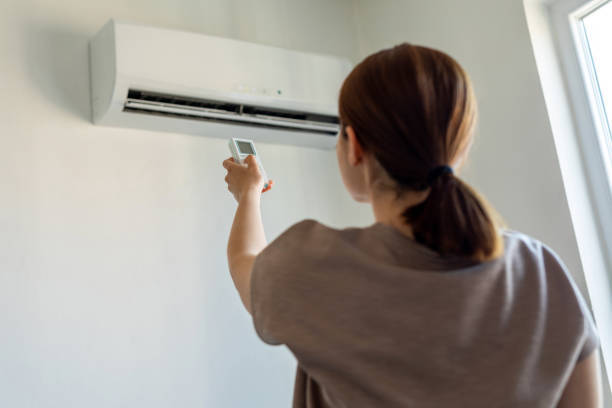
Table of Contents
As the leading HVAC service provider, we understand how frustrating it can be when your air conditioner refuses to turn on, especially during those sweltering summer days. This guide is designed to help you troubleshoot common AC issues and provide practical solutions to get your system up and running again. Whether you’re a DIY enthusiast or someone who prefers professional assistance, this comprehensive guide will cover all the bases.
Air conditioning systems are complex machines with many components, and a problem in any one of these can result in your AC not turning on. From electrical issues to mechanical failures, understanding the common reasons behind an AC not turning on can save you time, money, and a lot of discomfort.
Common Reasons Your AC Won't Turn On
Air conditioners can be complex systems, and there are several potential reasons why yours might not be turning on. Understanding these common issues is the first step toward a solution. Here are some of the most frequent culprits behind an AC that won’t turn on.
Electrical Issues
Tripped Circuit Breaker: One of the most common culprits behind an unresponsive AC unit is a tripped circuit breaker. Your AC system requires a substantial amount of power to operate, and sometimes, the circuit can get overloaded. To check, locate your home’s electrical panel and find the breaker labeled for your air conditioning unit. If it’s tripped, it will be in the middle position. Simply switch it off and then back on. If the breaker trips again, there could be a more serious electrical issue that requires professional attention.
- Location of Breaker Panel: Typically found in basements, garages, or utility rooms.
- How to Reset: Flip the tripped breaker to the off position, then back to on.
- When to Call a Professional: If the breaker repeatedly trips, indicating a potential wiring or component issue.
Blown Fuses: Another potential issue is blown fuses. These are usually found in the disconnect box near your outdoor unit. Fuses can blow due to power surges or overloading. To check, you’ll need to turn off the power and carefully open the box. If you see any burnt or damaged fuses, they need to be replaced. Always replace fuses with the same type and rating. If you’re uncomfortable doing this yourself, it’s best to call a professional.
- Signs of Blown Fuses: Visible damage or burnt appearance.
- How to Replace: Remove the old fuse and install a new one of the same rating.
- Safety Precautions: Always turn off the power before inspecting or replacing fuses.
Faulty Wiring: Electrical wiring issues can also prevent your AC from turning on. Over time, wiring can become frayed, disconnected, or even chewed through by pests. Inspecting the wiring should be done with caution and ideally by a professional, as mishandling electrical components can be dangerous. Signs of wiring issues include visible damage, exposed wires, or scorch marks.
- Common Causes: Wear and tear, pest damage, poor installation.
- Inspection Tips: Look for frayed or disconnected wires.
- Professional Help: Electrical wiring repairs should be conducted by licensed professionals to ensure safety and compliance with local codes.
Thermostat Problems
Thermostat problems are another frequent cause of your AC not turning on. The thermostat is essentially the command center of your air conditioning system, and if it’s not functioning correctly, your AC won’t turn on. Here’s what to look for:
Incorrect Settings: Sometimes, the solution is as simple as checking your thermostat settings. Ensure it is set to “cool” mode and that the temperature is set lower than the current room temperature. It’s also worthwhile to check if the fan is set to “auto” rather than “on” to ensure the AC turns on only when cooling is needed.
- Check Mode: Verify that the thermostat is set to “cool.”
- Set Temperature: Make sure the set temperature is below the room temperature.
- Fan Settings: Ensure the fan is set to “auto” to allow the system to operate efficiently.
Dead Batteries: If your thermostat is battery-operated, the batteries might be dead. This is an often-overlooked issue. Replace the batteries and see if the thermostat powers up. It’s a good idea to replace thermostat batteries at least once a year to avoid unexpected issues.
- Battery Type: Check your thermostat’s manual for the correct battery type.
- Replacement Frequency: Annually or when the low battery indicator appears.
- Power Up Check: After replacing, ensure the thermostat display is functional.
Malfunctioning Thermostat: If the thermostat display is blank or unresponsive, it may be malfunctioning. This can be due to internal faults or simple aging. Testing a thermostat involves checking the wiring and connections to ensure they are intact and functioning. If the thermostat is old or shows signs of malfunction, it might be time for a replacement.
- Display Issues: A blank or unresponsive display indicates a potential malfunction.
- Wiring Checks: Inspect the wiring connections for any loose or damaged wires.
- Upgrade Consideration: Older thermostats may benefit from an upgrade to newer, more reliable models.
Power Supply Issues
Ensuring your air conditioner unit has a reliable power supply is crucial. Power issues are another common reason for your AC not turning on. These can range from a complete power outage to specific issues affecting your AC unit alone.
Power Outage: Before diving into complex troubleshooting, make sure there isn’t a power outage in your area. Check if other electrical appliances in your home are working. If there’s a power outage, you’ll need to wait until power is restored.
- Outage Confirmation: Verify if other appliances or lights in your home are operational.
- Utility Company Check: Contact your local utility company for outage information.
- Patience Needed: Wait for power restoration if an outage is confirmed.
Disconnected or Loose Wires: Sometimes, wires can become loose or disconnected over time. This can happen due to vibrations or improper installation. Inspect the wiring connections at the unit and ensure they are secure. Always turn off the power before checking wires to avoid any risk of electric shock.
- Common Causes: Vibration, poor installation, pest interference.
- Inspection Process: Ensure all wires are securely connected.
- Safety First: Always turn off power at the breaker before inspecting wiring.
Sensor and Control Board Issues
Your AC system relies on a series of sensors and a control board to regulate its operations. Problems in these areas can prevent your AC from turning on.
Faulty Sensors: Your AC system relies on sensors to monitor and regulate its functions. If a sensor is malfunctioning, it can prevent the system from turning on. Sensor issues can be tricky to diagnose as they often require specialized equipment. Signs of sensor problems include irregular temperature readings or the system cycling on and off erratically.
- Temperature Sensors: Monitor temperature accurately to control cooling.
- Signs of Failure: Irregular readings, erratic system behavior.
- Diagnosis: Often requires professional tools and expertise.
Control Board Failure: The control board is essentially the brain of your AC system, managing all its functions. If it fails, the system won’t operate correctly. Indicators of a control board issue include erratic behavior, the unit not responding to commands, or no power reaching the system components. Diagnosing a control board problem typically requires a professional technician.
- Role of the Control Board: Manages all electrical functions of the AC.
- Symptoms of Failure: No response from the unit, erratic operation.
- Professional Diagnosis: Requires a trained technician to identify and fix.
For professional air conditioning repair for any of these issues, please contact us at HVAC Service Solutions using the link below.
https://thehvacservice.ca/repair-air-conditioners/
HVAC System Issues
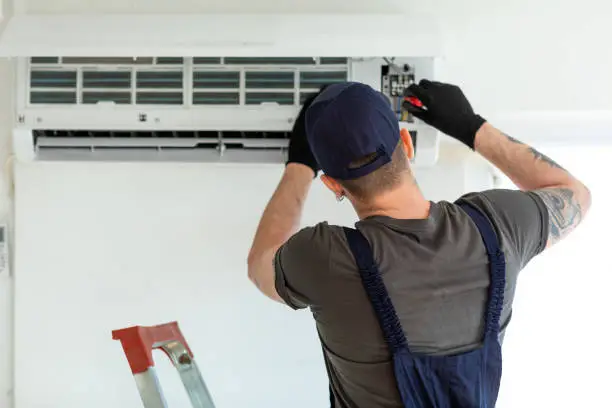
Beyond electrical and control problems, the AC unit itself can experience issues that prevent it from turning on. These problems often require maintenance or minor repairs to resolve.
Clogged Air Filters
Clogged air filters are a common and preventable issue that can cause your AC not to turn on. Dirty filters restrict airflow, causing the system to overheat and shut down as a protective measure. This not only prevents the AC from turning on but can also lead to long-term damage if not addressed.
Impact of Dirty Filters: One of the most common and preventable issues is a clogged air filter. Dirty filters restrict airflow, causing the system to overheat and shut down as a protective measure. This not only prevents the AC from turning on but can also lead to long-term damage if not addressed.
- Airflow Restriction: Limited airflow causes the system to work harder, leading to overheating.
- Overheating Risks: Overheating can trigger safety shutoffs to prevent damage.
- System Efficiency: Clean filters improve efficiency and longevity.
How to Replace Filters: Changing an air filter is a straightforward task. First, turn off the AC unit. Locate the filter, which is usually in the return air duct or the air handler cabinet. Remove the old filter and insert a new one, ensuring it’s the correct size and type. Regularly replacing air filters every 1-3 months can significantly improve your system’s performance and longevity.
- Location: Filters are usually located in return ducts or the air handler cabinet.
- Replacement Steps: Turn off the AC, remove the old filter, and insert a new one.
- Frequency: Replace every 1-3 months depending on usage and environment.
Frozen Coils
Frozen evaporator coils are another common issue that can cause your AC not to turn on. Frozen coils are typically a result of low refrigerant levels, poor airflow, or both. When the coils freeze, the AC system cannot operate efficiently, leading to a complete shutdown.
Frozen coils can be caused by low refrigerant levels, blocked air filters, or poor airflow. Identifying the cause is crucial to resolving the issue and preventing future occurrences.
- Low Refrigerant: Insufficient refrigerant can cause the coils to freeze.
- Airflow Blockages: Dirty filters or blocked vents restrict airflow, leading to frozen coils.
- System Issues: Malfunctions in the system can also contribute to freezing.
Thawing and Preventing Frozen Coils: If you suspect frozen coils, turn off the AC and let the system thaw. This can take several hours. To prevent future occurrences, ensure regular maintenance such as cleaning the coils, replacing filters, and maintaining proper refrigerant levels. If the problem persists, it’s essential to have a professional inspect the system.
- Thawing Process: Turn off the system and allow the coils to thaw naturally.
- Preventive Maintenance: Regularly clean and replace filters, and ensure proper refrigerant levels.
- Professional Help: Persistent issues may require a professional technician.
Refrigerant Problems
- Refrigerant issues are another common reason for your AC not turning on. Refrigerant is crucial for the cooling process. Low levels can cause the system to malfunction or not turn on at all. Signs of low refrigerant include hissing sounds (indicating a leak) and reduced cooling capacity.
Low Refrigerant Levels: Low refrigerant levels can cause the system to overheat and shut down. This can be due to leaks or improper charging during installation or servicing.
- Symptoms: Reduced cooling capacity, longer cooling cycles, hissing sounds.
- Common Causes: Leaks in the system, improper charging.
- Impact: System may overheat and shut down to prevent damage.
Refrigerant Leaks: Detecting and fixing refrigerant leaks should always be handled by a professional. Leaks not only prevent the AC from functioning but can also be harmful to the environment. Technicians use specialized equipment to locate and repair leaks, followed by recharging the system with the appropriate amount of refrigerant.
- Detection: Professionals use tools like electronic leak detectors to find leaks.
- Repair: Leaks should be repaired by certified technicians.
Recharging: After fixing the leak, the system needs to be recharged to the correct level. Find out how to fix the most common air conditioning repair problems by yourself in our previous article via the link below https://thehvacservice.ca/how-to-fix-the-most-common-air-conditioning-problems-by-yourself/
External Factors

Sometimes, the problem lies outside the unit itself. External factors can significantly impact the performance of your air conditioner unit. Addressing these can often resolve issues with your AC not turning on.
Blocked Vents and Registers
Blocked vents and registers can prevent your air conditioner unit from functioning correctly by restricting airflow.
Inspecting and Clearing Vents: Check all vents and registers in your home to ensure they are open and unobstructed. Blocked vents can restrict airflow, causing the system to overheat and shut down.
- Common Blockages: Furniture, drapes, and other household items can block vents.
- Inspection Steps: Walk through each room to ensure all vents are open.
- Cleaning Tips: Regularly vacuum and clean vents to ensure good airflow.
Importance of Unobstructed Vents: Proper airflow is critical for efficient operation. Make sure furniture, drapes, or other objects are not blocking the vents. Regularly vacuuming and cleaning the vents can also help maintain good airflow.
- Airflow Efficiency: Unobstructed vents help maintain efficient cooling.
- Energy Savings: Improved airflow can reduce energy consumption.
- Maintenance: Simple regular cleaning can prevent major issues.
Outdoor Unit Issues
The outdoor unit (condenser) plays a crucial role in your air conditioner unit‘s operation. Problems with this unit can cause your AC not to turn on.
Debris Around the Unit: The outdoor unit should be clear of debris such as leaves, grass, and dirt. This ensures adequate airflow and prevents overheating. Regularly inspect and clean the area around the unit.
- Common Debris: Leaves, grass clippings, and dirt can accumulate around the unit.
- Cleaning Process: Use a garden hose to gently wash away dirt and debris.
- Maintenance Schedule: Check the unit at least once a month, especially during high pollen seasons.
Condenser Coil Cleaning: Dirty condenser coils can impede heat transfer, making the system work harder and potentially causing it to shut down. Use a garden hose to gently clean the coils or hire a professional for a more thorough cleaning.
- Symptoms of Dirty Coils: Reduced cooling efficiency, increased energy usage.
- Cleaning Method: Gently spray coils with water; avoid using high-pressure hoses.
- Professional Cleaning: Consider a professional cleaning annually for optimal performance.
Blocked Drainage: The condensate drain line can become clogged with algae, dirt, or debris, causing water to back up and trigger a safety switch that prevents the AC from turning on. Regularly check and clean the drain line to avoid this issue.
- Signs of Clogs: Water pooling around the indoor unit, moldy smell.
- Cleaning Process: Use a wet/dry vacuum to clear clogs or pour a mixture of water and vinegar down the drain line.
- Preventive Measures: Regularly inspect and clean the drain line, especially during humid months.
Advanced Troubleshooting and Solutions
When basic troubleshooting doesn’t resolve the issue, it’s time to consider more advanced solutions. These often involve deeper inspection and potential professional intervention.
Professional Diagnostics
If you’ve tried the above solutions and your AC still won’t turn on, it’s time to call a professional AC service in Canada. Continuing to operate a malfunctioning unit can cause further damage and lead to costly repairs.
- Signs to Call a Professional: Persistent issues, recurring problems, unusual noises, or smells.
- Professional Benefits: Expertise, specialized tools, and a comprehensive diagnostic approach.
- Preventive Advice: Professionals can provide maintenance tips to avoid future issues.
Technicians will perform a comprehensive diagnostic to identify the root cause of the problem. This includes checking electrical components, refrigerant levels, sensor functionality, and overall system health. They’ll provide a detailed report and recommend necessary repairs or replacements.
Component Failures
Certain component failures within the air conditioner unit can prevent it from turning on. Addressing these often requires professional help due to the complexity and safety concerns.
Compressor Issues: The compressor is a vital component that circulates refrigerant throughout the system. Signs of compressor failure include strange noises, the unit not turning on, or the system struggling to cool. Compressor issues often require professional repair or replacement.
- Symptoms of Compressor Failure: Loud noises, inability to start, or inadequate cooling.
- Causes: Electrical issues, refrigerant problems, wear and tear.
- Solution: Compressor repair or replacement by a qualified technician.
Capacitor Problems: Capacitors store and release energy to power the AC’s motors. A faulty capacitor can prevent the unit from starting. Symptoms include clicking sounds, the fan not spinning, or the unit not turning on at all. Replacing a capacitor is a task best left to professionals due to the high voltage involved.
- Signs of Capacitor Failure: Clicking sounds, fan not operating, system not starting.
- Replacement Process: Requires careful handling due to high voltage; best performed by a technician.
- Regular Checkups: Include capacitors in routine maintenance checks to prevent sudden failures.
Motor Issues: Problems with the fan or blower motor can also prevent the AC from functioning. Signs include the fan not running, reduced airflow, or unusual noises. Motor issues typically require professional inspection and repair.
- Symptoms: Fan not spinning, weak airflow, unusual noises.
- Common Causes: Wear and tear, electrical problems, lack of maintenance.
- Professional Repair: Motor issues should be diagnosed and fixed by a technician.
Preventive Maintenance
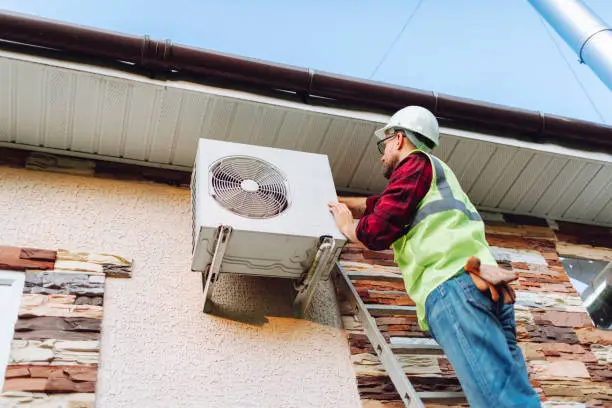
Regular preventive maintenance is essential for ensuring your air conditioner unit operates efficiently and avoids unexpected breakdowns. Here’s how you can maintain your system to prevent your AC from not turning on.
DIY Maintenance Tips
Routine maintenance can significantly extend the life of your system and improve energy efficiency. It includes tasks such as replacing filters, cleaning coils, and inspecting components.
Checklist for Homeowners:
- Replace Air Filters: Every 1-3 months, depending on usage.
- Clear Debris: Keep the area around the outdoor unit clear of leaves, grass, and other debris.
- Clean Condensate Drain Line: Regularly inspect and clean to prevent clogs.
- Inspect Vents and Registers: Ensure they are open and unobstructed.
- Check Thermostat Functionality: Ensure it is set correctly and working properly.
Conduct thorough checks and cleanings at the start of each cooling season to ensure your system is ready for heavy use.
Professional Maintenance Services
Scheduling professional AC maintenance can prevent major issues and improve system performance. Regular inspections and tune-ups can catch small problems before they become major repairs.
Seasonal Tune-Ups: Schedule a professional inspection and tune-up before the start of each cooling season. This includes checking refrigerant levels, cleaning components, and ensuring the system is operating efficiently.
Service Agreements: Signing up for a maintenance plan with HVAC Service Solutions offers numerous benefits. You’ll receive regular inspections, priority service, and discounts on repairs. This proactive approach helps prevent unexpected breakdowns and keeps your system in top condition.
Conclusion
In summary, there are many potential reasons why your AC won’t turn on, ranging from simple thermostat settings to complex electrical issues. By following the troubleshooting steps outlined in this guide, you can identify and resolve many common problems. Regular maintenance is essential for preventing issues and ensuring your system runs efficiently.
Remember, when in doubt, it’s always best to call a professional. HVAC Service Solutions is here to help with all your air conditioning needs. Contact us for expert service and advice.
Frequent Asked Questions
Why won't my AC turn on even though the thermostat is set correctly?
- If your AC won’t turn on despite the correct thermostat settings, several underlying issues could be the culprit. Firstly, check if the circuit breaker has tripped or if there’s a blown fuse; both can cut off power to the unit. Additionally, inspect the wiring for any signs of damage or disconnection, as faulty wiring can interrupt the system’s operation. A malfunctioning thermostat itself might be the issue, especially if it’s old or showing erratic behavior. Another possibility is low refrigerant levels, which can cause the system to overheat and shut down. Finally, a blocked condensate drain line can trigger a safety switch, preventing the AC from turning on. Addressing these potential problems often requires a systematic approach and, in some cases, professional assistance.
What should I check if my AC is not turning on at all?
When your AC is not turning on, start with the basics by checking the thermostat settings, ensuring it’s set to “cool” and the temperature is lower than the current room temperature. Next, examine the circuit breaker and fuses; a tripped breaker or blown fuse can interrupt power to the unit. Look for any loose or disconnected wires around the AC unit and thermostat, as these can prevent the system from receiving power. Additionally, ensure that the air filter is clean, as a clogged filter can cause the system to shut down due to restricted airflow. Verify that all vents and registers are open and unobstructed, promoting proper airflow throughout the system. If these checks don’t resolve the issue, the problem might lie within more complex components such as the compressor or control board, requiring a professional technician’s intervention.
How do I know if my AC's circuit breaker is tripped?
To determine if your AC’s circuit breaker is tripped, locate your home’s electrical panel, often found in the basement, garage, or utility room. Open the panel and look for the breaker labeled for your air conditioning unit. If it’s tripped, the switch will be in the middle position or slightly off-center. Reset it by firmly switching it off and then back on. If the breaker trips again immediately or shortly after resetting, it indicates a persistent issue such as an electrical short or overload, and you should contact a professional to diagnose and fix the problem. Repeated tripping can also signify a problem with the AC unit itself, such as a malfunctioning compressor or motor.
What are the signs of a blown fuse in my AC system?
Signs of a blown fuse in your AC system include a lack of power to the unit, even when the thermostat is set correctly, and other electrical components in your home are functioning properly. You might notice that the AC unit is completely unresponsive, with no signs of operation such as humming or fan movement. Upon inspecting the fuse, you may see visible damage or burn marks, indicating it has blown. Replacing a fuse requires matching the new fuse’s rating to the old one, ensuring safe and proper operation. However, if the new fuse blows shortly after replacement, it suggests an underlying issue within the system, such as an electrical short or overload, necessitating professional evaluation and repair.
Can a dirty air filter prevent my AC from turning on?
Yes, a dirty air filter can prevent your AC from turning on by restricting airflow, which causes the system to overheat and activate a safety shutoff mechanism. This protective measure prevents damage to the unit but results in it not operating until the issue is resolved. Regularly replacing air filters, ideally every 1-3 months, ensures adequate airflow and efficient system performance. A clogged filter not only hinders the AC from turning on but also reduces overall cooling efficiency and increases energy consumption. If your AC has been shutting down frequently, inspect the filter first and replace it if it’s dirty or clogged. Maintaining clean filters is a simple yet crucial step in ensuring the longevity and reliability of your air conditioning system.
What should I do if my AC unit keeps freezing up?
If your AC coils are frozen, start by turning off the AC to allow the coils to thaw completely. This thawing process can take several hours, so be patient. While the system is off, check and replace any dirty air filters that could be restricting airflow and causing the coils to freeze. Ensure that all vents and registers are open and unobstructed to promote proper air circulation. Once the coils have thawed, inspect for any signs of refrigerant leaks, as low refrigerant levels are a common cause of frozen coils. If you suspect a leak or if the coils freeze again, contact a professional technician to thoroughly inspect and address the issue. Regular maintenance, including cleaning the coils and ensuring proper refrigerant levels, can prevent future occurrences of frozen coils.
How can I tell if my AC has a refrigerant leak?
Detecting a refrigerant leak in your AC involves looking for specific signs such as hissing or bubbling noises near the refrigerant line, which indicate escaping gas. Another common symptom is reduced cooling efficiency; your AC may struggle to maintain the set temperature or take longer to cool the space. You might also notice the system running continuously without reaching the desired temperature, leading to higher energy bills. Additionally, ice buildup on the refrigerant line or evaporator coils suggests low refrigerant levels. If you suspect a refrigerant leak, it’s crucial to contact a professional technician. They will use specialized equipment to locate and repair the leak, followed by recharging the system with the correct amount of refrigerant to restore optimal performance.
Why is my thermostat blank and unresponsive?
A blank and unresponsive thermostat can be caused by several factors. First, check if the batteries need replacing, especially if the thermostat is battery-operated. Dead batteries are a common and easily fixed issue. If replacing the batteries doesn’t solve the problem, inspect the circuit breaker for any tripped switches that might cut power to the thermostat. Loose or damaged wiring can also lead to a blank display, so check for any visible wiring issues. If the thermostat remains unresponsive, it might be malfunctioning or outdated and require replacement. Ensure that the thermostat is compatible with your HVAC system when considering a new one. Persistent issues should be addressed by a professional technician to ensure proper diagnosis and repair.
When should I call a professional HVAC service?
You should consider calling a professional HVAC service if you experience persistent issues such as recurrent ice formation on your AC unit, despite performing basic maintenance. Complex problems like refrigerant leaks or major component failures require expert handling to prevent further damage and ensure optimal system performance.
Additionally, if you notice unusual noises or smells coming from your AC unit, it’s essential to seek professional assistance. These signs could indicate serious underlying issues that need immediate attention to prevent air conditioner freeze and ensure the safety and efficiency of your HVAC system.
Can outdoor debris affect my AC's performance?
Yes, outdoor debris can significantly affect your AC’s performance by obstructing airflow around the outdoor unit (condenser). Accumulated leaves, grass, dirt, and other debris can block the condenser coils, reducing the unit’s ability to dissipate heat efficiently. This blockage forces the system to work harder, leading to increased energy consumption and potential overheating. Regularly inspect and clear the area around the outdoor unit to maintain adequate airflow. Use a garden hose to gently clean the coils and remove any dirt buildup. Ensuring a debris-free environment around the condenser can improve your AC’s efficiency and prevent overheating or system failure.
When should I call a professional for AC issues?
You should call a professional for AC issues when basic troubleshooting steps fail to resolve the problem, or if you encounter recurring issues such as the system not turning on, unusual noises, or strange smells. Additionally, if you suspect complex problems like refrigerant leaks, compressor failure, or electrical issues, professional assistance is essential. Technicians have the expertise and tools to diagnose and fix intricate problems safely. Regular professional maintenance, ideally at the start of each cooling season, can prevent major breakdowns and ensure your system operates efficiently. Engaging a professional not only addresses immediate issues but also provides peace of mind and prolongs the life of your air conditioning unit.
Share

















